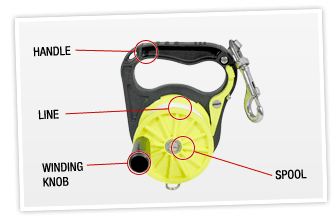Reels Buying Guide
« Back to Buying Guide Index
What's a Reel For?
Divers, especially technical divers, wreck divers, and cave divers rely on safety reels to give themselves an edge when in dangerous or treacherous diving situations. Reels are also used when lift bags are implemented by drift divers to signal their boat crews.
Reels are a diver's safety line. Wreck and cave divers use reels and safety lines much like Hansel and Gretel used bread crumbs. Reels and lines are a tried and true way for divers to return to their starting point. Simply anchor your line to a point just outside the cave opening or at the entrance point of the wreck and unroll your line from the spool as you progress through the dive. When it is time to exit the cave or wreck, turn around and slowly wind the line back onto the reel until you've exited the cave/wreck. Wreck divers are encouraged to tie off their lines to anchor points inside the wreck to avoid tangling the line on any debris within the wreck.
The simpler the reel, the more likely it'll function properly. When reels are loaded with gadgets and gizmos, there are more things that can break or go wrong. In order to work properly, a reel needs a spool, handle, and line. Of course, many of the additional features are highly desired by advanced divers or people who like the latest and greatest.
Line
When choosing the line to use with your reel, make sure it is strong and not likely to break if it comes in contact with sharp or jagged hazards in the diving environment. Most reel line is made of a durable, braided nylon.
Line comes in four sizes; #24, #26, #48, 1/8-inch. The various line sizes used depend on the reel's size and the application. #24 is the smallest line available and is used during cave dives when line length is more important than strength. When wreck diving, #24 will not sufficiently meet your needs; a #36 line or #48 line will work quite well for wreck diving. before it breaks. #36 is the next largest size followed by #48 which works very well on a wreck reel. Really large reels use 1/8 inch line, which is typically used for tech- nical diving.
The heavier and stronger the line, the less line the reel can accommodate and the heavier the reel/line become. Eventually, the bulk of the line can overpower the reel, causing the line to spill over one side of the reel.
- A 4-inch reel typically comes with approximately 400 feet of #24 line, 300 feet of #36 line, 250 feet of #48 line, or 110 feet of 1/8-inch line.
- A 3-inch reel typically comes with approximately 175 feet of #24 line, 130' feet of #36 line, and 100 feet of #48 line.
- A 5-inch reel typically comes with approximately 800 feet of #24 line, 550 feet of #36 line, 425 feet of #48 line, or 250 feet of 1/8-inch line.
Winding & Tension

Winding Knobs
When selecting which reel to use, take your other gear into consideration. If you wear thick gloves while diving, a finger spool might not be a very effective design for you. Cold water divers frequently prefer reels that have winding knobs, which allow them to wind the spool more easily.
Tension Control
Some reels offer tension control, which is typically controlled by a spring. Tension control keeps your line on your reel from free-spooling, or uncontrollably unwinding off of the spool. A strong argument for using a reel with tension is it allows you to control the rate at which a lift bag moves to the surface.
Reel Accessories:
-

Line Arrows
In order to avoid any confusion about which way is out, use line arrows on your reel line to point you to- ward your closest exit.
-

Jon Line
Buy yourself a little breathing room. Use a Jon line during your decompressions stops to tether yourself to the anchor line and then float a slight distance from the line to keep you from bumping into other decom- pressing divers.
-

Save-a-Dive Kit
The last thing you want to do is find out on the beach or dive boat that something is wrong with your gear, and not have a way to fix the problem. By carrying a save-a-dive kit, you can still safely enjoy your dive or snorkeling adventure just like you planned.
